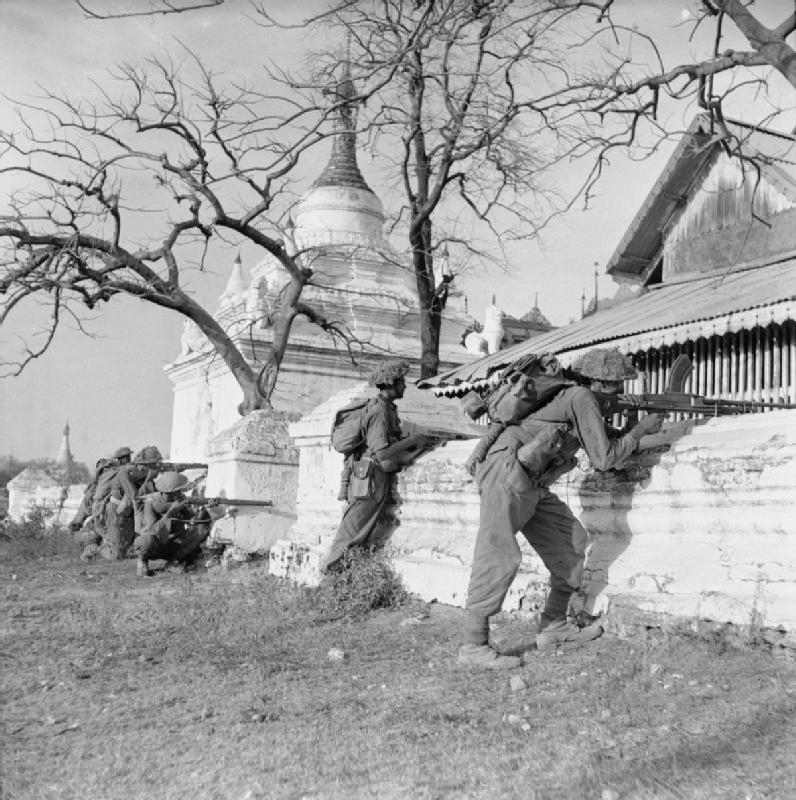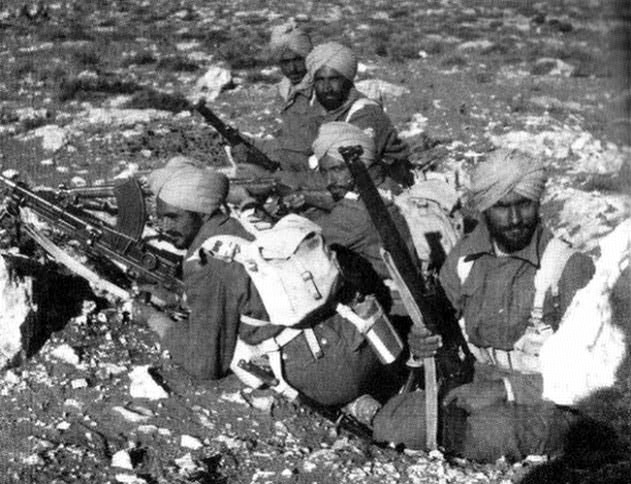sidewinder
Active member
The Indian Army during World War II in 1939, numbered just under 200,000 menBy the end of the war it would become the largest volunteer army in history, rising to over 2.5 million men in August 1945. Serving in divisions of infantry, armour and a fledgling airborne force, they fought on three continents in Africa, Europe and Asia.
The Indian Army fought in Ethiopia against the Italian Army, in Egypt, Libya and Tunisia against both the Italian and German Army, and, after the Italian surrender, the German Army in Italy. However the bulk of the Indian Army was committed to the fighting the Japanese Army, first during the defeat in Malaya and the retreat from Burma to the Indian border. Then after resting and refitting the victorious advance back into Burma, part of the largest British Empire army ever formed. These campaigns cost the lives of over 36,000 Indian servicemen, another 34,354 more were wounded, and 67,340 became prisoners of war. Their valour was recognised with the award of 4,000 decorations and 38 members of the Indian Army were recipients of the Victoria Cross or the George CrossThe Indian Army was an experienced force, having fought in the Third Afghan War and two major campaigns in Waziristan, during 1919–1920 and 1936–1939 and in smaller disputes on the North West Frontier since World War I. There was no shortage of manpower to call upon
1940
In May 1940, agreement was reached between the British and Indian governments over the formation of another five infantry and one armoured divisions, which became the 6th, 7th, 8th, 9th, 10th infantry and the 31st Indian Armoured Divisions. These new divisions were intended to be used in the defence of Malaya (9th Division) and Iraq (6th, 8th and 10th Divisions). The 3rd Indian Motor Brigade, from the armoured division, was to go to Egypt but the formation of the rest of the armoured division was put on hold, because of the shortage of armoured vehicles.
1941
In March 1941, the Indian government revised the defence plan for India. Concerned with what the Japanese were planning and the requirement to replace the divisions sent overseas, seven new armoured regiments and 50 new infantry battalions were needed for five new infantry divisions that were formed: the 14th, 17th, 19th, 20th, 34th and the two armoured formations 32nd Indian Armoured Division and 50th Indian Tank Brigade.
1942
With the previously formed divisions mostly committed overseas in 1942, the army formed another four infantry divisions (23rd, 25th, 28th, 36th) and the 43rd Indian Armoured Division. However events during 1942, and the Japanese conquests meant the 28th division was not formed and the units earmarked for it were used elsewhere. The 36th division uniquely, was created as a British Indian Army formation, but was formed from British brigades that had reached India from the Madagascar campaign and from Britain. The final division formed in 1942 was the 26th Indian Infantry Division, which was hastily formed from the various units in training or stationed near Calcutta.
After the perceived poor performance in battles in Malaya and Burma in 1942, it was decided that the existing infantry divisions were over–mechanized. To counter this the 17th and 39th divisions were selected to become light divisions, of only two brigades which would rely more on animal and four-wheel-drive transport.
By December 1942, agreement was reached that India should become the base for offensive operations. Support should be in place for 34 divisions, which would include two British, one West African, one East African and eleven Indian divisions, and what was left of the Burma Army.
1943
The plans for 1943 included the formation of another infantry division, an airborne division and a heavy armoured brigade. Only the 44th Indian Armoured Division was formed, by amalgamating the 33rd and 43rd armoured divisions. There was a change to the infantry division formation, when they received two extra infantry battalions as divisional troops.
A committee was set up in 1943 to report on the readiness of the army and suggest improvements. Its recommendations were:
The infantry should have first claims on cadet officers and educated recruits, the quality of officers and non commissioned officers (NCO) should be improved and there should be an increase in pay.
Basic training should be increased to nine months followed by two months' specialised jungle training.
The reinforcement system should be improved and drafts should include experienced NCO's
Infantry brigades should include a British, an Indian and a Gurkha battalion.
To assist in the jungle training of the infantry from July 1943, the 14th and 39th divisions were converted to training divisions.The 116th Indian Infantry Brigade, part of 39th Division, provided the specialised jungle conversion training. An infantry battalion would spend from four to six months with the brigade, before being sent to the front to replace a tired battalion in one of the fighting divisions. The brigades and units of the 14th Division provided jungle training for drafts of reinforcements for the Indian battalions already serving on the Burma front.
1944
The planned 44th Indian Airborne Division was finally formed from the 44th Armoured Division, leaving the 31st Armoured as the only armoured division in the army.The infantry division formation was changed again; they were now standardised with three infantry brigades each and three infantry battalions assigned as divisional troops.
The success of the 116th brigade in training for jungle warfare was recognised. From in May 1944, 116th Brigade trained units destined for the Fourteenth Army and 150th Brigade, which was converted from the Risalpur Training Brigade, trained units destined for the Southern Army. The 155th Indian Infantry Brigade was formed to provide training for units destined for the western theatres of war.:salute2:
The Indian Army fought in Ethiopia against the Italian Army, in Egypt, Libya and Tunisia against both the Italian and German Army, and, after the Italian surrender, the German Army in Italy. However the bulk of the Indian Army was committed to the fighting the Japanese Army, first during the defeat in Malaya and the retreat from Burma to the Indian border. Then after resting and refitting the victorious advance back into Burma, part of the largest British Empire army ever formed. These campaigns cost the lives of over 36,000 Indian servicemen, another 34,354 more were wounded, and 67,340 became prisoners of war. Their valour was recognised with the award of 4,000 decorations and 38 members of the Indian Army were recipients of the Victoria Cross or the George CrossThe Indian Army was an experienced force, having fought in the Third Afghan War and two major campaigns in Waziristan, during 1919–1920 and 1936–1939 and in smaller disputes on the North West Frontier since World War I. There was no shortage of manpower to call upon
1940
In May 1940, agreement was reached between the British and Indian governments over the formation of another five infantry and one armoured divisions, which became the 6th, 7th, 8th, 9th, 10th infantry and the 31st Indian Armoured Divisions. These new divisions were intended to be used in the defence of Malaya (9th Division) and Iraq (6th, 8th and 10th Divisions). The 3rd Indian Motor Brigade, from the armoured division, was to go to Egypt but the formation of the rest of the armoured division was put on hold, because of the shortage of armoured vehicles.
1941
In March 1941, the Indian government revised the defence plan for India. Concerned with what the Japanese were planning and the requirement to replace the divisions sent overseas, seven new armoured regiments and 50 new infantry battalions were needed for five new infantry divisions that were formed: the 14th, 17th, 19th, 20th, 34th and the two armoured formations 32nd Indian Armoured Division and 50th Indian Tank Brigade.
1942
With the previously formed divisions mostly committed overseas in 1942, the army formed another four infantry divisions (23rd, 25th, 28th, 36th) and the 43rd Indian Armoured Division. However events during 1942, and the Japanese conquests meant the 28th division was not formed and the units earmarked for it were used elsewhere. The 36th division uniquely, was created as a British Indian Army formation, but was formed from British brigades that had reached India from the Madagascar campaign and from Britain. The final division formed in 1942 was the 26th Indian Infantry Division, which was hastily formed from the various units in training or stationed near Calcutta.
After the perceived poor performance in battles in Malaya and Burma in 1942, it was decided that the existing infantry divisions were over–mechanized. To counter this the 17th and 39th divisions were selected to become light divisions, of only two brigades which would rely more on animal and four-wheel-drive transport.
By December 1942, agreement was reached that India should become the base for offensive operations. Support should be in place for 34 divisions, which would include two British, one West African, one East African and eleven Indian divisions, and what was left of the Burma Army.
1943
The plans for 1943 included the formation of another infantry division, an airborne division and a heavy armoured brigade. Only the 44th Indian Armoured Division was formed, by amalgamating the 33rd and 43rd armoured divisions. There was a change to the infantry division formation, when they received two extra infantry battalions as divisional troops.
A committee was set up in 1943 to report on the readiness of the army and suggest improvements. Its recommendations were:
The infantry should have first claims on cadet officers and educated recruits, the quality of officers and non commissioned officers (NCO) should be improved and there should be an increase in pay.
Basic training should be increased to nine months followed by two months' specialised jungle training.
The reinforcement system should be improved and drafts should include experienced NCO's
Infantry brigades should include a British, an Indian and a Gurkha battalion.
To assist in the jungle training of the infantry from July 1943, the 14th and 39th divisions were converted to training divisions.The 116th Indian Infantry Brigade, part of 39th Division, provided the specialised jungle conversion training. An infantry battalion would spend from four to six months with the brigade, before being sent to the front to replace a tired battalion in one of the fighting divisions. The brigades and units of the 14th Division provided jungle training for drafts of reinforcements for the Indian battalions already serving on the Burma front.
1944
The planned 44th Indian Airborne Division was finally formed from the 44th Armoured Division, leaving the 31st Armoured as the only armoured division in the army.The infantry division formation was changed again; they were now standardised with three infantry brigades each and three infantry battalions assigned as divisional troops.
The success of the 116th brigade in training for jungle warfare was recognised. From in May 1944, 116th Brigade trained units destined for the Fourteenth Army and 150th Brigade, which was converted from the Risalpur Training Brigade, trained units destined for the Southern Army. The 155th Indian Infantry Brigade was formed to provide training for units destined for the western theatres of war.:salute2:







